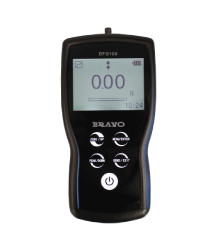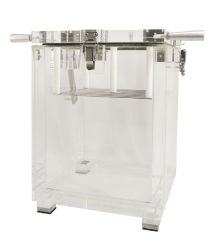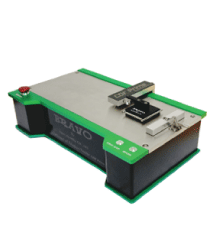Corrosion Test Apparatus
What It's For
Test on gases evolved during combustion of electric cables
The International Electrotechnical Commission IEC 60754 Part 1 and Part 2 test is performed to determine the degree of acidity of gases evolved during the combustion of materials taken from electric cables by measuring the pH and conductivity.
Cable users have expressed concern over the amount of acid gas which is evolved when cable insulating, sheathing and other materials are burnt as this acid can cause extensive damage to electrical and electronic equipment not involved in the fire itself. It has been considered necessary, therefore, to develop an approved method (by extensive round robins) for determining the amount of acid gases evolved by burning cable components so that limits can be agreed for cable specifications. As the test is not carried out on a complete cable test piece, for a hazard assessment the actual material volumes of the cable components should be taken into consideration.
- Tube furnace, support stand and thermocouples
- Quartz work tube and sample lading assembly
- Control unit with digital temperature controller for tube furnace, optional over temperature device and sample temperature indicator
- 2 gas collection bottles
- Gas cell 1 litre
- pH and conductivity measuring instruments with digital display and electrodes
- Stirrer
- Air flowmeter and all necessary tubes and connections
- 10 ceramic sample boats
- Furniture (ASTM E1474)
- Wall lining materials (ASTM E1740)
- Prison mattresses (ASTM F1550)
- Electric cables (ASTM D6113)
- Railway rolling-stock applications (EN 45545-2)
- Maritime applications (IMO)
FTIR Toxicity Test
What It's For
- ISO 19702
- ISO 9705
- EN 17084
Combustion Toxicity Test Apparatus
The ASTM E1678
- The sample orientation is horizontal
- Suitable for testing sample assemblies
- Polycarbonate chamber of 200 litres
- Heat Flux Meter
- Irradiation levels 10-50kW/m²
- Spark ignition
- Load Cell with sample capacity of 500g
- 15 ports for outlet to gas analysers
The NFPA 269
Toxicity Test Apparatus
What's for
The NES 713 is used for the determination of the toxicity index of the products of combustion from small specimens of material.
- The Chamber has a steel framework for strength and is constructed from fire retardant grade polypropylene with welded seams and a volume of 0.7 cubic metres.
- The Door, which gives full access to the Chamber for easy cleaning is constructed from clear polycarbonate sheet, backed with laminate for strength and rigidity.
- Gas Burner has a spark ignition system which automatically re-ignites should the flame extinguish.
- 15 sampling positions are provided for use with colorimetric Gas Reaction Tubes or optional specific Gas Analysers.
- Separate Control Unit houses the Flowmeters, Timer, Methane and Air Controls.
- Forced-air extraction system for evacuating the Chamber after a test.
- Internally mounted Stirring Fan for rapid mixing of combustion products.
- Chamber Dimensions (mm) 1100 (W) × 800 (D) × 1300 (H)
- Control Unit Dimensions (mm) 530 (W) × 270 (D) × 280 (H)
- Voltage: Dual – 110V-60Hz 3A – 230V-50Hz 2A
- Weight: 70kg
Toxicity Test Attachment for NBS Smoke Density Chamber
What's for
Used in conjunction with the NBS Smoke Density Chamber, gaseous/volatile test products are drawn from the chamber at any time for analysis through three ports on the top of the chamber. One of these ports is used to connect to the ABD0031 vacuum box.
This test method is used for evaluating materials or constructions used in the interior of aerospace vehicles, but may be utilised for other applications as specified in applicable procurement and regulatory documents. It is used to measure and describe the properties of materials, products or assemblies in response to heat and flame under controlled laboratory conditions. Results of this test may be used as elements of a fire risk assessment which takes into account all of the factors which are pertinent to an assessment of the fire hazard of a particular end use.
Cone Corrosimeter
What's For
- ASTM D5485
- ISO 11907-4
Evaluating Thermal Runway Fire Propagation
what's for
The UL 9540A standard has been developed to test battery energy storage systems in different scales :
• Cell level
• Module level
• Unit level
• Installation level
The Cell Level Test
The Module Level Test
The Unit Level Test
The testing principle from the module level test can be applied to the unit level test measuring
fires up to 10MW by increasing the hood size, exhaust diameter and exhaust flow rate, as
explained in ISO 24473, Open Calorimetry – Measurement of the rate of production of heat and
combustion products for fires up to 40MW.
The unit level test involves heating up several cells in a battery energy storage system (BESS) to initiate thermal runaway and collecting the gaseous products under a hood and exhaust system with an internal diameter of 1.524m (in order to measure heat release rates up to 10MW). A sample
of the gases in the exhaust are analysed for the concentration of oxygen, carbon dioxide, carbon
monoxide and hydrocarbons as well as the composition of additional gases using FTIR. In
addition the amount of smoke in the exhaust is measured using a white light smoke measurement
system. The environment around the BESS is instrumented in order to measure the temperature and heat flux at adjacent walls and secondary BESS systems.
The Installation Level Test
Installation level tests are only required for non-residential installations. The test configuration is similar to the Unit Level test, but does not measure the heat release and smoke production rates.
The installation level test involves heating up several cells in a battery energy storage system (BESS) to initiate thermal runaway in a room which contains a sprinkler system or other fire and explosion mitigation methods. A sample of the gases in the room is taken and analysed for the concentration of hydrocarbons and hydrogen as well as the composition of additional gases using FTIR. The environment around the BESS is instrumented in order to measure the temperature and heat flux at adjacent walls and secondary BESS systems.



